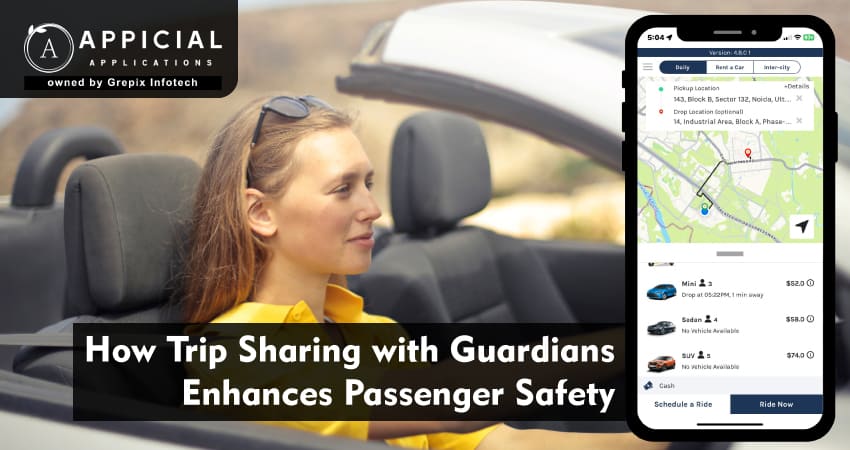
How Trip Sharing with Guardians Enhances Passenger Safety
In the evolving world of mobility, passenger safety is becoming a defining differentiator for successful platforms. Features that once felt “nice to have” are now demanded by users and regulators alike. Among these innovations, trip sharing with guardians, wherein a passenger’s trip status is monitored or shared with a trusted third-party (guardian) in real time is gaining traction.
For any modern ride sharing app, ride hailing app, or e-hailing app, and for those building an Uber Clone or a white label taxi booking app, offering guardian-sharing features is no longer optional. A forward-looking taxi app development company or white label taxi app development company must embed this functionality to meet user expectations, regulatory pressure and competitive demands.
This blog delves into why guardian trip-sharing is vital, how it works, what benefits it offers, and how platforms can integrate it successfully. It covers the roles of users, drivers, and platforms; the technological architecture; the challenges; and best practices.
This article examines the growing importance of trip sharing with guardians as a safety enhancement for passengers using ride-hailing services. It explores how this feature addresses evolving user concerns, the technological and operational requirements for integration, the benefits for platforms, drivers and passengers alike, the challenges involved, and the strategic role for a taxi app development company or white label taxi app development company when implementing it in an Uber Clone, ride sharing app, ride hailing app or e-hailing app. It concludes by promoting Appicial Applications as a partner for building such robust solutions, with a clear call to action.
Why Guardian Trip-Sharing Is Critical in Today’s Ride-Hailing Ecosystem
What is driving the demand for enhanced safety features?
Consumers’ expectations for safety in a ride hailing app or ride sharing app are increasing. The digital-on-demand mobility model connects strangers in enclosed spaces. In this context, passengers feel vulnerable. Data supports this: for example, a recent federal report found that three major ridesourcing companies reported about 4,600 serious sexual assault incidents tied to trips they arranged in 2019. Government audit offices have flagged gaps in data and oversight in the rides and taxi sector. In response, users expect platforms to provide stronger safeguards.
A ride sharing app that offers only the basic driver-profile and route tracking features may no longer satisfy safety-conscious users. By contrast, a feature which allows a user to share their trip status with a guardian or set up real-time alerts boosts trust and perception of safety. That is why an Uber Clone or white label taxi booking app that fails to support guardian-sharing risks being perceived as inferior.
Why the traditional “track my ride” is not enough
Many existing e-hailing apps already offer live-tracking, SOS buttons, and driver background screening. These are valuable, but they are reactive at best. Guardian trip-sharing adds a proactive dimension: trusted contacts are looped in, trip progress is visible, deviations trigger alerts, and in some cases, guardians can intervene. This adds a layer of oversight beyond the driver-passenger pair. When implemented by a taxi app development company, such features can help platforms address user safety concerns more comprehensively.
Regulatory and reputational implications
Regulators in many regions are focusing more on passenger safety in ride-hailing platforms. For instance, oversight bodies have recommended transparency in incident data and mandated safety features. Platforms that demonstrate strong guard-rails gain trust from both authorities and users. In a saturated market of ride hailing apps, safety features including guardian-trip-sharing become distinguishing features. For a white label taxi app development company, integrating these from the outset can give clients a competitive edge.
Changing demographics and use-cases demand stronger safety
Younger riders, solo female passengers, and users travelling late-night or in unfamiliar geographies increasingly use ride-hailing services. They expect safety features that go beyond basic tracking. Guardian trip sharing is directly relevant: it addresses solitary travel, unfamiliar routes, or travelling after dark. This matters for both a ride sharing app with broad demographic reach and a niche Uber Clone targeting high-risk segments. The value of guardian safety is amplified in these contexts.
What Are the Key Benefits of Trip Sharing with Guardians?
For Passengers (Enhanced Sense of Safety and Control)
A passenger using a ride hailing app that allows them to designate a guardian feels more secure. They have control, they choose who can see their trip, they can trigger alerts or cancellations if something goes wrong, and they build trust in the platform. That confidence translates into higher usage frequency, lower churn, and higher lifetime value. When building your Uber Clone or white label taxi booking app, offering guardian sharing can be a major user satisfaction driver.
For Guardians (Visibility and Peace of Mind)
When a guardian (friend, family member, colleague) is given visibility into a trip, they can follow progress, see unexpected route changes, or receive end-trip confirmation. This helps reduce anxiety, especially for first-time users or high-risk riders. From the platform’s perspective, enabling this helps convert skeptical users into frequent users of the ride sharing app or e-hailing app.
For Drivers and Platform (Lower Risk and Higher Trust)
When passengers feel safer, usage increases. When guardians feel included, rejection of the trip may go down. A taxi app development company can build logs and analytics for guardian interactions, enabling platforms to detect trip anomalies early, respond faster to incidents, and improve overall safety scoring. Additionally, when safety incidents reduce or drivers feel more supported, driver retention improves.
For Brand and Market Differentiation
In a competitive landscape, a white label taxi app development company that supplies a white label taxi booking app enriched with guardian-sharing capability positions its clients as premium, safety-first operators. That clarity helps in marketing, app store listing, and user acquisition. A platform built with this in mind stands out from typical ride-hailing ventures.
For Data-Driven Insights and Continuous Improvement
Guardian-sharing features generate additional data: how often users share trips, how often guardians intervene, patterns of route deviation alerts, etc. A ride sharing app or ride hailing app can use this data for safety scoring, driver training, and fraud detection. The architecture designed by a taxi app development company can include analytics modules that capture guardian-related events and feed dashboards with actionable insights.
How Does Guardian Trip-Sharing Work in a Ride-Hailing Platform?
What are the functional components?
A fully functioning guardian-trip-sharing module in an Uber Clone or e-hailing app includes several elements:
- Interface for the passenger to designate one or multiple guardians.
- Permissioned access for guardians to view trip progress, pick-up and drop-off status, driver and vehicle details.
- Automated notifications to guardians at key milestones (e.g., ride start, mid-trip, unexpected detour, arrival).
- Alert/override mechanism enabling the passenger (or guardian) to trigger driver reassignment or emergency support.
- Logging infrastructure capturing all events for audit, analytics and compliance.
How does the user-flow change in a ride sharing app?
From the passenger’s perspective:
- When booking a ride via your ride hailing app, user sees an option: “Add guardian/share trip with someone”.
- Passenger selects a guardian contact (via mobile number or email).
- Guardian receives link or access token to monitor the trip.
- Once driver is assigned and trip begins, the guardian interface shows driver details, route, ETA, and any alerts.
- At trip end, both passenger and guardian receive confirmation.
- If anomalies occur (delay, route change beyond threshold, SOS event), guardian is notified and platform support may intervene.
What must the backend architecture of a taxi app development company accommodate?
The backend must integrate:
- Real-time location tracking (already common in white label taxi booking apps).
- Access controls managing guardian permissions.
- Middleware for notifications (push, SMS, email) triggered by trip events.
- Dashboards for platform and drivers monitoring guardian interactions.
- Analytics for anomaly detection (route deviations, SOS triggers, frequency of guardian usage).
- Data storage architecture to log events for compliance, incident investigations, and continuous improvement.
What Challenges Should Platforms Anticipate and How to Overcome Them?
Could guardian-sharing be under-adopted?
Yes. Some users may not choose to share their trip out of privacy concerns or inertia. Educating users is essential. UX must make the option intuitive and compelling. A ride hailing app can emphasise “Share your ride for peace of mind” messaging. A taxi app development company should design the onboarding flow to highlight benefits.
Risks of false alarms and alert fatigue
If the system triggers too many alerts (route deviations that are benign, slight delays tolerated by user) guardians may become desensitised. To mitigate, define smart thresholds and allow users/guardians to fine-tune alert preferences. Analytics from a ride sharing app can inform optimal thresholds over time.
Data privacy and regulatory risks
Handling sensitive location and personal data requires robust privacy compliance. The platform must ensure encrypted data, secure access, logging, and transparent user consent. A white label taxi app development company must build the module with privacy-by-design. Failure may lead to regulatory penalties and reputational damage.
Integration with driver workflows and platform load
Driver apps must accommodate potential reassignment triggered by guardian alerts. Platform dispatch systems need to handle dynamic shifts. Building this flexibility adds complexity. A taxi app development company must design the dispatch engine and fallback logic accordingly.
Cost-benefit for platforms
Implementing guardian-sharing means additional modules, development cost, increased infrastructure for tracking and analytics. The business case must justify it. However, given rising user expectations, competitive advantage and safety compliance, the investment pays off in retention, brand trust and differentiated positioning.
What Metrics and KPIs Should You Track?
Guardian-sharing adoption rate
Track the percentage of rides where the passenger opts to share their trip with a guardian. A higher rate indicates stronger user trust and feature resonance. Your Uber Clone or ride hailing app should aim for adoption of 20-30%+ initially, with growth over time.
On-time arrival and incident rate for shared rides
Compare scheduled/tracked rides with and without guardian sharing. Are rides with guardian-sharing less likely to have delays, cancellations or complaints? This can demonstrate safety benefit. For example, research shows ride-sharing introduction reduced alcohol-related traffic fatalities by 6 % in the US. This suggests well-built platforms can drive measurable safety improvements.
Alert triggers and resolution time
Track how many guardian alerts were triggered, and the average response time from the platform (driver reassignment, user contact, etc.). Faster resolution builds trust.
Driver rating and retention for shared-trip drivers
See if drivers who frequently service guardian-shared trips have higher satisfaction ratings and lower drop-off. This indicates that safety features benefit driver ecosystem as well.
User retention and lifetime value
Monitor whether users who use guardian-sharing feature are more likely to become repeat users, increase spend, and refer others. This demonstrates business value beyond safety.
Incident escalation and costs
Track frequency of major incidents (route deviation, SOS activations) for rides with guardian-sharing vs without. Lower incident costs strengthen ROI proposition for the feature.
How to Position Guardian Trip-Sharing in Your Uber Clone / White Label Strategy?
What should you look for in a taxi app development company?
When selecting a taxi app development company or white label taxi app development company, make sure they:
- Have experience with advanced safety modules (guardian-sharing, SOS, fallback logic).
- Offer modular architecture so you can add guardian sharing without re-engineering the whole platform.
- Provide analytics dashboards which track guardian sharing usage and outcomes.
- Ensure privacy, permission and data-security compliance built in.
- Can integrate guardian workflows seamlessly in both passenger and driver apps and the dispatch backend.
How to launch in phases
In your ride sharing app or ride hailing app, you may want to launch guardian-sharing in a targeted pilot: for certain user segments (e.g., late-night rides), for high-risk geographies, or corporate clients. Monitor adoption and perform iterative improvements before a full rollout. Your white label taxi booking app should support a toggle-on/off capability for guardian module.
How to market the feature
Promote guardian-sharing as a trust-and-safety differentiator. Use messaging like: “Share your ride with a loved one in one tap.” Highlight that your Uber Clone enables real-time guardian monitoring. Use app-store badges like “Safety first”, “Guardian share built-in”. Encourage users to invite guardians when they onboard. Offer small incentives (e.g., first guardian-shared ride free) to drive trial.
Also Read: Running a Taxi App While Managing Your Full-Time Job in Seychelles: Complete Guide
How to integrate operations and support
Operationally, guardian-sharing may require support-team training to handle guardian queries or alerts. Your taxi app development company should build dashboards enabling support agents to see guardian status, initiate escalations, view logs. Ensuring operational readiness is as important as front-end integration.
How to iterate and improve
Collect user feedback on guardian-sharing usability and perceived safety. Use analytics to fine-tune alert thresholds, modify UX, reduce false positives. A white label taxi app development company should provide analytics modules and support for continuous enhancement.
Why Choose Appicial Applications for Your Ride-Hailing Platform With Guardian Trip-Sharing?
When building a full-featured ride sharing app, ride hailing app, or e-hailing app with guardian-sharing functionality as part of your safety-first offering, choosing the right development partner is critical.
Appicial Applications offers state-of-the-art solutions including:
- A full-stack Uber Clone solution tailored for your market, with optional modules for guardian trip-sharing built-in.
- Expertise in safety-centric design: both passenger and guardian UX flows, secure permissioning, alert logic, real-time tracking, and analytics.
- Modular architecture ideal for a white label taxi booking app or e-hailing app, enabling you to brand and deploy quickly while retaining flexibility.
- Comprehensive analytics dashboards capturing guardian share KPIs, incident alerts, response times, driver performance and user retention metrics.
- Support for privacy compliance, data encryption, guardian-access controls, and audit logs, essential for regulatory readiness.
- Post-launch support and iterative enhancement: you get not just an app but a partner helping you extract value from safety features and refine your offering over time.
If you are ready to build a differentiated ride hailing app or ride sharing app that stands out on safety, trust and user-engagement and features a robust guardian-sharing capability, Appicial Applications is the partner you need.
Ready to elevate passenger safety and set your platform apart? Contact Appicial Applications today for a free consultation and demo. Let us build your next-gen Uber Clone / white label taxi booking app with guardian trip-sharing built-in.
Conclusion
As urban mobility evolves, passenger safety ceases to be a nice-to-have feature and becomes a strategic imperative. Features such as trip sharing with guardians amplify trust, improve driver- and passenger-experience, reduce risk and enable platforms to differentiate in a crowded ride hailing app and ride sharing app market. For companies building an Uber Clone or deploying a white label taxi booking app, integrating guardian-sharing is no longer optional, it is essential.
From user onboarding flows, guardian permissions, real-time tracking, notifications, alert logic, analytics, to support operations and privacy compliance, the design and implementation require specialist skill. That is why selecting an experienced taxi app development company or white label taxi app development company is so important.
With Appicial Applications as your partner, you can launch a future-proof ride-hailing platform that puts safety at its core. Don’t wait — create the next era of trust-first mobility today.
FAQs
Author's Bio

Vinay Jain is the Founder at Grepix Infotech and brings over 12 years of entrepreneurial experience. His focus revolves around software & business development and customer satisfaction.
Back to blog list




